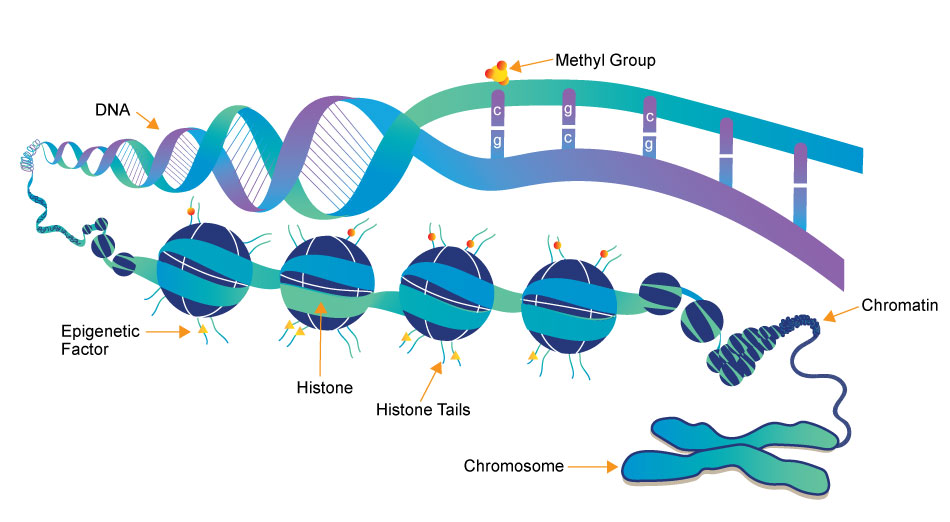Epigenetics


Epigenetics research delves into the molecular mechanisms that control gene expression and cellular traits without altering the underlying DNA sequence. One crucial aspect of this field is the role of small molecules, which act as powerful regulators of epigenetic modifications. These small compounds, typically comprising a few dozen to a few hundred atoms, have emerged as essential tools in understanding and manipulating the epigenome.
- DNA Methylation Inhibitors: Small molecules like 5-azacytidine and 5-aza-2'-deoxycytidine are DNA methyltransferase inhibitors. They block the addition of methyl groups to DNA, leading to DNA demethylation. This can reactivate silenced genes, potentially offering therapeutic avenues for conditions like cancer.
- HDAC inhibitors: HDACs remove acetyl groups from histone proteins, contributing to gene repression. Small molecule HDAC inhibitors, such as Vorinostat and Romidepsin, can reverse this process by increasing histone acetylation, allowing genes to be more accessible for transcription. These inhibitors are being explored for cancer therapy and other conditions.
- Histone Methyltransferase Inhibitors: Small molecules like GSK126 inhibit specific histone methyltransferases, affecting histone methylation patterns. This can alter gene expression, making them promising candidates for cancer and other diseases with epigenetic dysregulation.
- RNA Modulators: Small molecules can also target non-coding RNAs involved in epigenetic regulation. For instance, small molecules called small interfering RNAs (siRNAs) can be designed to target and degrade specific long non-coding RNAs, influencing gene expression.
- Epigenetic Reader Domain Inhibitors: These small molecules target proteins that recognize and bind to specific epigenetic marks. Examples include inhibitors of bromodomain-containing proteins (BET inhibitors), which can disrupt gene regulation by interfering with protein-DNA interactions.
Small molecules in epigenetics research not only provide insights into the fundamental biology of gene regulation but also hold immense promise for developing novel therapeutics. Their ability to selectively modulate specific epigenetic marks and pathways has led to ongoing clinical trials and drug development efforts for various diseases, including cancer, neurological disorders, and inflammatory conditions. Understanding and harnessing the power of these small molecules is at the forefront of modern epigenetics research, offering new hope for precision medicine and targeted therapies.
3 key components involved in the regulation of epigenetic modifications
Epigenetics Writer
Epigenetics writers are enzymes responsible for adding chemical marks or modifications to DNA or histone proteins. These marks include DNA methylation (addition of methyl groups to DNA) and histone modifications (such as acetylation, methylation, phosphorylation, etc.).
Epigenetics Reader
Function: Epigenetics readers are proteins that can recognize and bind to specific epigenetic marks on DNA or histones. These reader proteins interpret the epigenetic code and facilitate downstream cellular processes, such as gene activation or repression.
Epigenetics Eraser
Function: Epigenetics erasers are enzymes responsible for removing or reversing epigenetic marks on DNA or histones. This process allows for the dynamic regulation of gene expression and the resetting of epigenetic states during various stages of development and in response to environmental changes.
-
HDAC 抑制剂
CXD101 是一种 I类选择性HDAC抑制剂(HDAC1(IC50,63 nM),HDAC2(IC50,570 nM),HDAC3(IC50,550 nM)。CXD101 对 HDAC II类 无活性。 -
p300 抑制剂
Histone Acetyltransferase Inhibitor II 是一种强效且能渗透细胞的 p300 抑制剂,具有 5μM 的 IC50;Histone Acetyltransferase Inhibitor II 可用于癌症研究。 -
BET 抑制剂
PFI-1 是一种 BET 溴结构域抑制剂,对 BRD2 和 BRD4 表现出抑制活性。- Lisa-Maria Winter, .et al. , Sci Rep, 2023, Jul 26;13(1):12061 PMID: 37495707
-
HDAC 抑制剂
Resminostat,亦称为 RAS2410,是一种强效的组蛋白去乙酰化酶(HDAC)I类和II类的抑制剂。它通过结合并抑制 HDACs,导致高度乙酰化的组蛋白积累。 -
pan-JAK 抑制剂
PF-06263276(PF 6263276)是一种强效且选择性的全面JAK抑制剂,其IC50分别为JAK1的2.2 nM、JAK2的23.1 nM、JAK3的59.9 nM和TYK2的29.7 nM。 -
PARP 抑制剂
PJ 34 盐酸盐是一种强效的聚(ADP-核糖)聚合酶(PARP)抑制剂(EC50 = 20 nM)。- Wigle TJ, .et al. , SLAS Discov, 2019, Dec 19:2472555219883623 PMID: 31855104
- Alvin Z.Lu, .et al. , Biochem Pharmacol, 2019, May 7. pii: S0006-2952(19)30171-6 PMID: 31075269
-
JAK2/FLT3 抑制剂
Pacritinib,也被称为 SB1518,是一种口服生物可利用的 Janus kinase 2 (JAK2) 和 JAK2 突变体 JAK2V617F 的抑制剂,具有潜在的抗肿瘤活性。Pacritinib 与 JAK2 竞争 ATP 结合,这可能导致抑制 JAK2 激活,抑制 JAK-STAT 信号通路,从而引发依赖半胱天冬酶的凋亡。- Angelina T Regua, .et al. , Cancer Lett, 2024, Jun 7:597:217023 PMID: 38852701
- Daniel Doheny, .et al. , Oncogene, 2020, Oct;39(42):6589-6605 PMID: 32929154
-
EZH2 抑制剂
EPZ-6438 是一种强效、选择性且口服生物利用度高的小分子抑制剂,专门针对 EZH2 酶活性。它能特异性地在 SMARCB1 缺失的 MRT 细胞中诱导凋亡和分化。- Yang PM, .et al. , Am J Cancer Res, 2019, Oct 1;9(10):2120-2139 PMID: 31720078
- Wang Z, .et al. , J Cell Mol Med, 2019, May 13 PMID: 31087496
- Theresa Baker, .et al. , Oncotarget, 2015, Oct 20; 6(32): 32646-32655 PMID: 26360609
-
BET 抑制剂
(+)-JQ1 是一种高效、高亲和力、选择性的 BET 溴结构域抑制剂。- Jiang Zhou, .et al. , Neoplasia, 2025, Oct:68:101223 PMID: 40850308
- Kei Taga, .et al. , Microbiol Immunol, 2024, Mar;68(3):90-99 PMID: 38244193
- Deeksha Sharma, .et al. , Breast Cancer Res, 2023, Nov 15;25(1):144 PMID: 37968653
- Adriana K Alexander, .et al. , Nat Commun, 2023, Mar 29;14(1):1753 PMID: 36990976
- Haruki Kitamura, .et al. , Biochem Biophys Res Commun, 2023, Jan 22;641:139-147 PMID: 36527748
- Gerald Thiel, .et al. , Pharmaceuticals (Basel), 2022, Jul 10;15(7):846 PMID: 35890145
- Selase D Deletsu, .et al. , Biochem Biophys Res Commun, 2021, Aug 27;567:106-111 PMID: 34146904
- Cole Schonhofer, .et al. , Biochem Pharmacol, 2021, Apr;186:114462 PMID: 33577894
- Nandini Verma, .et al. , Sci Adv, 2020, 6 : eaba8968
- Kuo MT, .et al. , Transl Oncol, 2020, 13(2):355-364 PMID: 31887630
- Rao Z, .et al. , J Immunol, 2019, Aug 15;203(4):1031-1043 PMID: 31300512
- A Carrer, .et al. , Cancer Discov, 2019, Jan 9. pii: CD-18-0567 PMID: 30626590
- Clocchiatti A, .et al. , J Clin Invest, 2018, Dec 3;128(12):5531-5548 PMID: 30395538
-
DOT1L 抑制剂
EPZ-5676 是一种小分子抑制剂,针对组蛋白甲基转移酶,具有潜在的抗肿瘤活性。- Yoo H, .et al. , Cell Death Dis, 2020, Jan; 11(1): 14 PMID: 31908356
- Guang Bai, .et al. , Epigenetics of Chronic Pain, 2019, Pages 1-48
-
DNMT 抑制剂
SGI-110 是一种第二代 DNA-去甲基化剂。- Lise Brault, .et al. , EMBO Mol Med, 2025, Aug 29 PMID: 40883610
- Sho Sato, .et al. , Sci Rep, 2023, Jan 27;13(1):1537 PMID: 36707610
-
HDAC6 抑制剂
ACY-241 是一种新型、选择性的、可口服的 HDAC6 抑制剂。- Bae J, .et al. , Leukemia, 2018, Sep;32(9):1932-1947 PMID: 29487385
-
SUV39H HMT 抑制剂
Chaetocin 是一种组蛋白甲基转移酶 SUV39H1 抑制剂(IC50 = 0.8 μM)。在体外能诱导多发性骨髓瘤细胞系发生凋亡;在体内小鼠多发性骨髓瘤模型中表现出抗增殖活性。- Linna Han, .et al. , Biochem J, 2023, Mar 31;480(6):421-432 PMID: 36896918




